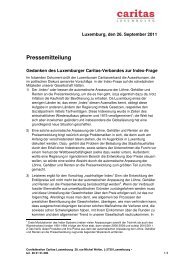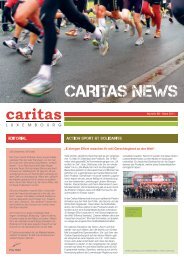Sozialalmanach - Caritas Luxembourg
Sozialalmanach - Caritas Luxembourg
Sozialalmanach - Caritas Luxembourg
Create successful ePaper yourself
Turn your PDF publications into a flip-book with our unique Google optimized e-Paper software.
the European Union (EU) have undertaken comprehensive welfare reform in the years since<br />
the 1990s in particular 15 . Taken together these reforms add up to a momentum of system<br />
change that goes far beyond the popular concepts of failed neo-liberal ‘retrenchment’<br />
and the ‘new’ politics of the welfare state as the politics of the ‘status quo’. Moreover,<br />
cleavage conflicts over issues like childcare and leave arrangements, employment protection<br />
legislation and active aging, are being fought out within mainstream social democratic and<br />
Christian democratic parties, rather than between left and right 16 . If we interpret the welfare<br />
state more broadly than aggregate social spending, a finer grained qualitative analysis of<br />
long term policy evolution reveals a process of profound yet gradual transformation across<br />
several related policy areas 17 . Limiting ourselves to the more critical reform measures, in<br />
a wide array of countries, at least seven key reform trends can be identified – each briefly<br />
introduced here.<br />
In macroeconomic policy, up until the late 1970s, Keynesian priorities, geared toward<br />
full employment as a principal goal of economic management, prevailed. In the face of<br />
stagflation the Keynesian order gave way to a stricter macroeconomic policy framework<br />
centred on economic stability, hard currencies, low inflation, sound budgets, and debt<br />
reduction, culminating in the introduction of the European Monetary Union (EMU).<br />
Building on two decades of monetary integration, EMU has transferred monetary policy,<br />
a core function of the modern welfare state, to an independent central bank (ECB) and<br />
it has significantly constrained member states’ fiscal policy discretion 18 . Also countries<br />
that have decided to stay out of EMU have moved towards hard currency regimes with<br />
increasingly independent central banks, modelled after the ECB.<br />
In the field of wage policy, a reorientation took place in the 1980s in favour of marketbased<br />
wage restraint in order to facilitate competitiveness, profitability, and employment<br />
under conditions of growing economic internationalization. Strategies of wage moderation<br />
have been pursued in many countries through a new generation of social pacts in Europe,<br />
linked with wider packages of negotiated reform, making taxation, social protection,<br />
pension and labour market regulation more ‘employment friendly’. The rediscovery of a<br />
jobs-intensive growth path in Denmark, Finland, Ireland and the Netherlands, by way of a<br />
first generation of new social pacts, has also allowed the social partners to strike deals over<br />
productivity, training, and job opportunities for less productive workers. In the 1990s, the<br />
15 Boeri et al. (2001); Boeri et al. (2005); Ferrera & Hemerijck (2003); Brandt et al. (2005).<br />
16 Stiller (2007); Korthouwer (2010).<br />
17 Hemerijck & Schludi (2000); see also Brandt et al. (2005).<br />
18 Featherstone & Dyson (1999); Martin & Ross (2004).<br />
156








